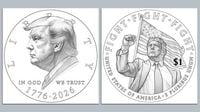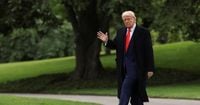The U.S. Treasury Department has ignited fierce debate and national curiosity with its consideration of a new $1 coin featuring President Donald Trump, timed to mark the 250th anniversary of American independence in 2026. What began as a routine commemoration has quickly become a flashpoint for legal, political, and cultural controversy—one that’s as much about the nation’s identity as it is about the metal in our pockets.
The story broke wide open on October 3, 2025, when U.S. Treasurer Brandon Beach shared draft images of the proposed coin on the social media platform X, a move promptly retweeted by Treasury Secretary Scott Bessent. The images were anything but subtle: one side showed Trump’s profile with the word “liberty” above and the dates “1776-2026” below, while the reverse depicted Trump with a raised, clenched fist, the phrase “FIGHT, FIGHT, FIGHT” arching overhead, and an American flag in the background. According to Reuters and Axios, this design directly references Trump’s reaction after surviving an assassination attempt during his election campaign the previous year—a moment that, for supporters, symbolizes resilience and defiance.
But even as the coin’s design captivated some and outraged others, a crucial legal question loomed: is it even lawful? Federal statutes are clear—at least on paper. As Axios reported, 31 U.S. Code § 5112 states, “No coin issued under this subsection may bear the image of a living former or current President.” The Circulating Collectible Coin Redesign Act of 2020 goes further, prohibiting “any head and shoulders portrait or bust of any person, living or dead, and no portrait of a living person” on commemorative coins for the U.S. semiquincentennial. An even older law from 1866 bans living people’s portraits from appearing on U.S. currency, though that was written with paper money in mind. The U.S. Mint, which produces coins, operates under a slightly different set of rules than the Bureau of Engraving and Printing, which handles bills. Still, the spirit of the law is hard to miss: living presidents simply aren’t supposed to be featured on U.S. money.
There is, as historians have pointed out, one notable exception. In the 1920s, President Calvin Coolidge appeared alongside George Washington on a commemorative half-dollar—the only time a sitting president’s likeness has graced U.S. coinage. But even that precedent is thin ice; it’s rarely cited as justification for breaking with tradition. According to the U.S. Mint, Coolidge’s appearance is the lone outlier in more than two centuries of American currency.
So what makes the Trump coin different? For one, the political climate. The coin’s unveiling comes as the federal government remains partly shut down, a situation both sides of the aisle blame on each other. In a statement to Daily Sun and Axios, a Treasury spokesperson took aim at the “radical left’s forced shutdown of our government,” before adding, “Under the historic leadership of President Donald J. Trump, our nation is entering its 250th anniversary stronger, more prosperous, and better than ever before.” The spokesperson continued, “While a final $1 dollar coin design has not yet been selected to commemorate the United States’ semiquincentennial, this first draft reflects well the enduring spirit of our country and democracy, even in the face of immense obstacles.”
White House Press Secretary Karoline Leavitt was asked during an October 3rd briefing if President Trump had seen the draft. “I’m not sure if he’s seen it, but I’m sure he’ll love it,” she replied, as reported by Reuters and Axios. Her response summed up the mood in Washington: part bemusement, part anticipation, and a hefty dose of uncertainty.
The coin’s supporters have wasted no time rallying behind the idea. Conservative activist Steve Guest posted on X, “ATTENTION ALL PATRIOTS: America is back, and so is the one-dollar coin. @POTUS @realDonaldTrump will forever be the face of America’s 250th Birthday…” This sentiment, echoed by many on the right, frames the coin as a tribute to Trump’s perceived embodiment of American resilience, especially in light of the assassination attempt. For these supporters, the coin is not just a piece of metal, but a symbol of survival and national renewal.
Critics, however, see things very differently. Legal experts warn that minting the coin could set a dangerous precedent, blurring the lines between commemoration and political propaganda. Some argue that the design is an overtly political gesture, ill-suited to the spirit of the nation’s 250th birthday. Others question whether the coin’s production is even legal, given the explicit statutory bans. The debate has spilled onto social media, with some Americans expressing pride and others voicing deep discomfort at the prospect of a living president—especially one as polarizing as Trump—being immortalized on U.S. currency.
Adding to the intrigue is the legislative backdrop. The 2020 law, signed by Trump during his first term, authorizes the Treasury to mint $1 coins “with designs emblematic of the U.S. semiquincentennial.” The law allows these coins to be issued during the year starting January 2026. But nowhere does it explicitly override the ban on featuring living presidents. As Reuters notes, the proposed design attempts to sidestep the law by using a wider illustration of Trump on the reverse, rather than a formal “head and shoulders” portrait. Whether this will satisfy legal scrutiny remains to be seen.
For now, the coin’s fate hangs in the balance. Treasurer Beach has promised more details “once the obstructionist shutdown of the United States government is over.” In the meantime, the draft design remains just that—a draft, both a celebration and a lightning rod for controversy. The episode has become a microcosm of America’s broader struggle to define its identity at a moment of both celebration and division.
Numismatists and historians alike are watching closely. The last time the U.S. marked a milestone anniversary—in 1976—the Treasury sponsored a national competition for the $1 coin, ultimately choosing a design featuring the Liberty Bell and the moon. The other side bore the image of President Dwight D. Eisenhower, who had passed away years earlier. That coin was about unity and the passage of time; the Trump coin, if it comes to pass, will be about something else entirely.
As July 4, 2026, draws nearer, Americans will be watching to see not only whether the coin is minted, but what story their currency will tell. Will it be a tale of legal acrobatics and partisan divides, or a symbol of national endurance? For now, the Trump $1 coin remains a potent reminder that in the United States, even a coin can spark a national debate about who we are, what we value, and how we choose to remember our history.

